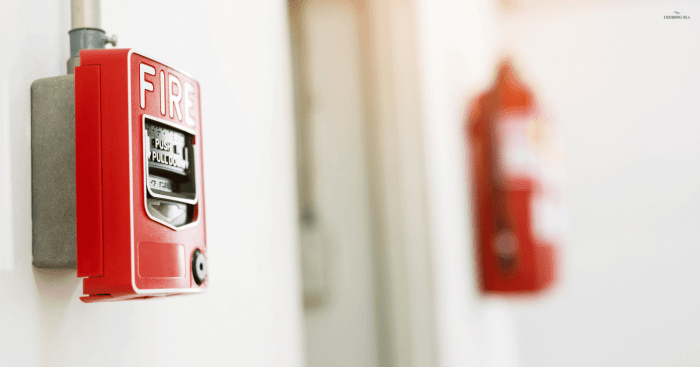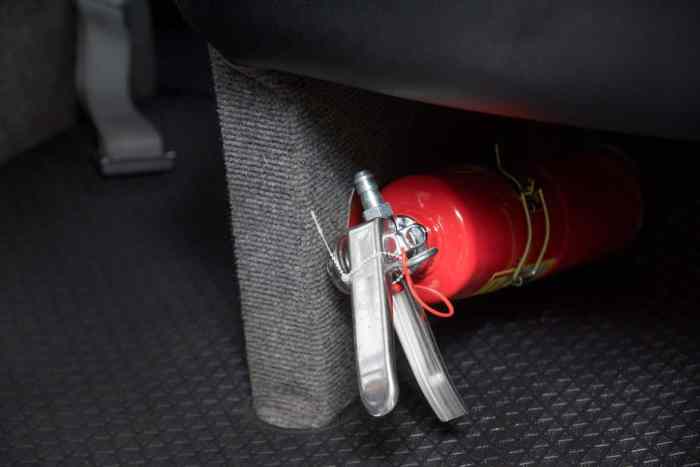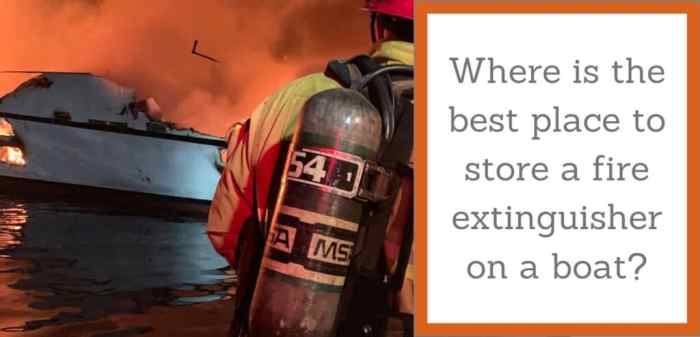Best place to store fire extinguisher on boat – In the realm of boating safety, the judicious placement of fire extinguishers is paramount. This guide delves into the best practices for storing fire extinguishers on boats, ensuring their accessibility, visibility, and effectiveness in the event of an emergency.
Understanding the types of fire extinguishers suitable for boats and their specific applications is crucial. We explore the characteristics, advantages, and limitations of water, foam, dry chemical, and CO2 extinguishers, empowering boat owners to make informed decisions based on potential fire risks.
Accessibility and Visibility: Best Place To Store Fire Extinguisher On Boat

Fire extinguishers should be placed in easily accessible and visible locations to ensure prompt and effective use in case of a fire. The optimal height for mounting fire extinguishers is between 30 and 50 inches from the floor, allowing for easy reach and visibility.
The distance from potential fire hazards should be considered to ensure quick access in an emergency. In areas with limited space, recessed or flush-mounted extinguishers may be used to maintain accessibility while minimizing obstruction.
Suitable mounting locations include:
- Near the helm or navigation station
- In the engine room or compartment
- In the galley or kitchen area
- On the flybridge or deck
- Near fuel tanks or flammable storage areas
Types of Fire Extinguishers
Different types of fire extinguishers are suitable for boats, each with specific applications and characteristics:
- Water extinguishers: Effective on Class A fires (ordinary combustibles like paper, wood, and fabrics) but not on electrical fires or flammable liquids.
- Foam extinguishers: Suitable for Class A and B fires (flammable liquids like gasoline and oil), creating a foam blanket to smother the fire.
- Dry chemical extinguishers: Effective on Class A, B, and C fires (electrical equipment), discharging a dry chemical powder to smother and extinguish the fire.
- CO2 extinguishers: Used on Class B and C fires, discharging a cloud of carbon dioxide to displace oxygen and suffocate the fire.
The choice of fire extinguisher should be based on the potential fire risks on the boat, considering the materials present and the likelihood of different fire types.
Maintenance and Inspection
Regular maintenance and inspection of fire extinguishers are crucial to ensure their functionality and effectiveness:
- Visual inspections: Monthly checks for any damage, corrosion, or leaks.
- Pressure checks: Annual checks to ensure proper pressure levels.
- Discharge tests: Periodic testing to verify the extinguisher’s discharge mechanism and agent.
Fire extinguishers should be stored in a cool, dry place away from direct sunlight and moisture. Proper handling and storage prevent damage or malfunction.
Legal and Regulatory Requirements, Best place to store fire extinguisher on boat
Most countries have legal or regulatory requirements regarding the placement and maintenance of fire extinguishers on boats:
- US Coast Guard: Requires boats to have at least one Type B-1 fire extinguisher for every 26 feet of length.
- American Boat and Yacht Council (ABYC): Provides guidelines for the number, type, and placement of fire extinguishers based on boat size and type.
Non-compliance with these regulations can result in fines or penalties. It is essential to adhere to safety regulations to ensure the safety of passengers and the vessel.
Additional Safety Considerations
In addition to fire extinguishers, other safety measures enhance fire prevention and preparedness:
- Smoke and carbon monoxide detectors: Detect the presence of smoke or carbon monoxide, providing early warning of a fire.
- Fire prevention practices: Avoiding smoking indoors, storing flammable materials safely, and maintaining electrical systems reduce fire risks.
- Emergency fire safety plan: Outlining procedures for fire detection, evacuation, and extinguishing.
- Fire drills: Practicing emergency procedures to ensure familiarity and effectiveness.
User Queries
Where is the most accessible and visible location to store a fire extinguisher on a boat?
The optimal location is within easy reach, typically near the helm or cockpit, where it can be quickly retrieved in case of an emergency.
What type of fire extinguisher is most suitable for a boat?
Dry chemical extinguishers are commonly recommended for boats due to their versatility in extinguishing various types of fires, including electrical, fuel, and grease fires.
How often should fire extinguishers on boats be inspected?
Regular inspections are crucial. It is recommended to conduct visual inspections monthly, pressure checks annually, and discharge tests every six years.

